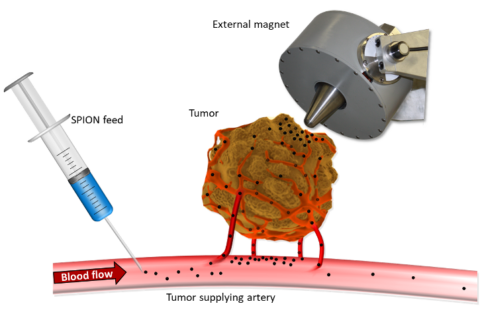Targeted cancer therapy

Magnetic nanoparticles for drug delivery
Nel Schulte is studying in the Elite Master’s program “Advanced Materials and Processes” (MAP) at the Friedrich-Alexander-Universität Erlangen-Nürnberg. In his Master’s thesis at the Section for Experimental Oncology and Nanomedicine (SEON) under Prof. Dr. med. Christoph Alexiou in collaboration with Prof. Dr.-Ing. habil. Dr. h.c. Aldo R. Boccaccini, he is researching the development of magnetic nanoparticles that can be loaded with drugs and used in cancer therapy.
Conventional chemotherapy has severe side effects
Cancer is already the second most common cause of death in the western world, with increasing number of cases. Conventional therapy with chemotherapeutic agents comes with severe side effects such as infertility, anemia, damage to other organs, nausea or diarrhea. At the same time, high doses are often required for effectivity. Therefore, there is a great demand for novel innovative treatment strategies with fewer side effects and greater efficacy. One approach is magnetic drug delivery to the tumor tissue. The chemotherapeutic drugs are bound to superparamagnetic iron oxide nanoparticles (SPIONs), which in turn are enriched in the tumor after injection into the bloodstream with the aid of a magnetic field. However, it has not yet been possible to bring such a system into clinical application.
For a successful clinical application, the new treatment method must not only be effective, but also economical and reliable to produce.
The surface of the particles is crucial
The surface coating of the SPIONs is essential for their properties. It prevents the particles from agglomerating, enables the binding of medication and determines how the body reacts to the particles. At SEON, the SPIONs are coated with albumin, a main transport protein in human blood. This takes on the tasks of stabilization and drug binding and is well tolerated by the immune system. In his Master’s thesis, Nel is attempting to optimize the binding reaction of the albumin to the SPIONs and to characterize the resulting particles physicochemical and to investigate their biological effect on blood and cells.
Holistic research close to everyday clinical practice
Research at SEON endeavors to cover the entire path along the development of nanoparticle systems. For this, an international and interdisciplinary team works closely together in areas such as nanoparticle production, characterization, toxicology, biology, imaging and pharmaceutical production.
Thanks to its interdisciplinary orientation, the Elite Master’s program MAP has equipped Nel with the necessary tools for research at SEON at the interface of materials science, chemistry, medicine and biology.
Learn more about the Section for Experimental Oncology and Nanomedicine:
https://www.hno-klinik.uk-erlangen.de/seon-nanomedizin/

By MAP student Nel Schulte (matriculation group 2021)
